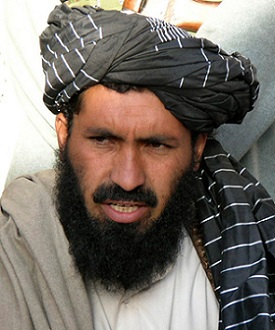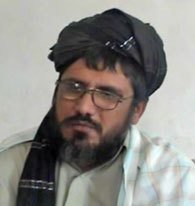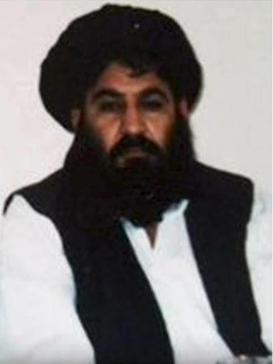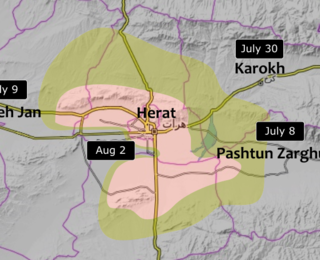
Mullah Muhammad Omar was an Afghan mujahideen commander, revolutionary, and the cleric who founded the Taliban. During the Third Afghan Civil War, the Taliban fought the Northern Alliance and took control of most of the country, establishing the First Islamic Emirate for which Omar began to serve as Supreme Leader in 1996. Shortly after al-Qaeda carried out the September 11 attacks, the Taliban government was toppled by an American invasion of Afghanistan, prompting Omar to go into hiding. He successfully evaded capture by the American-led coalition before dying in 2013 from tuberculosis.

Dadullah was the Taliban's most senior militant commander in Afghanistan until his death in 2007. He was also known as Maulavi or Mullah Dadullah Akhund. He also earned the nickname of Lang, meaning "lame", because of a leg he lost during fighting.

Operation Achilles was a NATO operation, part of the War in Afghanistan. Its objective was to clear Helmand province of the Taliban. The operation began on March 6, 2007. The offensive is the largest NATO-based operation in Afghanistan to date. NATO officials reported that, contrary to previous operations, Taliban fighters were avoiding direct confrontation in favor of guerilla tactics.

Mullah Mansoor Dadullah was the Taliban militant commander Mullah Dadullah's younger half-brother who succeeded him as a senior military commander of the Taliban in southern Afghanistan. He came from the Arghandab district of Kandahar province, and belonged to the Kakar Pashtun tribe.

Maulvi Nazir was a leading militant of the Pakistani Taliban in South Waziristan. Nazir's operations were based in Wana.

Muhammad Rasul was the leader of the High Council of the Islamic Emirate of Afghanistan, a Taliban dissident group in Afghanistan, until the group's dissolution in 2021. He was a Taliban-appointed governor of Nimruz Province, Afghanistan. Rasul exerted pressure and suppression on Pashtun factions unpopular with the Taliban, and made a considerable fortune controlling cross-border drug-smuggling through Nimruz.
2003 in Afghanistan. A list of notable incidents in Afghanistan during 2003

The Mullah Dadullah Front was an insurgent group in Afghanistan that claimed responsibility for a series of bombings and assassinations centered in Kabul.

Akhtar Mohammad Mansour was the second supreme leader of the Taliban. Succeeding the founding leader, Mullah Omar, he was the supreme leader from July 2015 to May 2016, when he was killed in a US drone strike in Balochistan, Pakistan.

The Sacrifice Front, more commonly known as Fidai Mahaz, was a Taliban splinter group and faction in the War in Afghanistan. It was led by Mullah Najibullah, also known as Omar Khitab, a former Taliban commander.

Najibullah, often referred to as Mullah Najibullah or Hajji Najibullah, and also known by the pseudonym Omar Khitab, is an Afghan militant leader who is the head of the Taliban splinter group Fidai Mahaz in Afghanistan.

Mullah Hibatullah Akhundzada, also spelled Haibatullah Akhunzada, is an Afghan cleric who is the supreme leader of Afghanistan in the internationally unrecognized Taliban regime. He has led the Taliban since 2016, and came to power with its victory over U.S.-backed forces in the 2001–2021 war. A highly reclusive figure, he has almost no digital footprint except for an unverified photograph and several audio recordings of speeches.

Mullah Mohammad Yaqoob Mujahid is an Afghan militant commander and cleric who is the second deputy leader of Afghanistan and the acting defense minister in the internationally unrecognized Taliban regime since 2021. He has been a deputy leader of the Taliban since 2016, and was additionally appointed to his ministerial role after the Taliban's victory over Western-backed forces in the 2001–2021 war. He has been the Taliban's military chief since 2020.
Usman Ghazi was the Emir of the Islamic Movement of Uzbekistan, a militant group based in Afghanistan and Pakistan. He succeeded Usman Adil after the latter's death in a drone strike.

The Afghan Armed Forces, officially the Armed Forces of the Islamic Emirate of Afghanistan and also referred to as the Islamic Emirate Armed Forces, is the military of Afghanistan, commanded by the Taliban government from 1997 to 2001 and since August 2021. According to Afghanistan's Ministry of Defense, its total manpower is 170,000.

The Islamic State–Taliban conflict is an ongoing insurgency by the Islamic State Khorasan Province (IS-KP) against the Taliban regime in Afghanistan. The conflict initially began when both operated as rival insurgent groups in Nangarhar; since the formation of the Taliban's state in 2021, IS-KP members have enacted a campaign of terrorism targeting both civilians and assassinating Taliban members using hit-and-run tactics. The group have also caused incidents and attacks across the border in Pakistan.

The Supreme Leader of Afghanistan, officially the Supreme Leader of the Islamic Emirate of Afghanistan and also styled by his religious title Amir al-Mu'minin, is the absolute ruler, head of state, and national religious leader of Afghanistan, as well as the leader of the Taliban. The supreme leader wields unlimited authority and is the ultimate source of all law.

The Fall of Herat was a battle and subsequent capture of Herat by Taliban fighters. The attack on the city started around 28 July 2021, and ended in Taliban victory by 13 August of the same year. Several of the surrounding districts fell to the Taliban from June to mid-July, leaving only the city and two other districts in government hands by 10 July. The border crossings in Herat Province were captured by the Taliban on 9 July, raising prices of goods inside the city. Ismail Khan, former governor and warlord, led a public uprising force to assist the Afghan National Security Forces in defending the city.
The government of Afghanistan, officially called the Islamic Emirate of Afghanistan and informally known as the Taliban government, is the central government of Afghanistan, a unitary state. Under the leadership of the Taliban, the government is a theocracy and an emirate with political power concentrated in the hands of a supreme leader and his clerical advisors, collectively referred to as the Leadership. The Leadership makes all major policy decisions behind closed doors, which are then implemented by the country's civil service and judiciary. As Afghanistan is an Islamic state, governance is based on Sharia law and Pashtunwali, which the Taliban enforces strictly through extensive social and cultural policies.
Mullah Abdul Manan Niazi was an Afghan politician and military commander. In the 1990s, he was the governor of the Herat and Balkh provinces. He was one of the famous commanders of the splinter group of the Taliban led by Mullah Rasool, and one of the helpers of the Taliban group led by Mullah Hibatullah Akhundzada. He was also a critic of the policy of regional countries, especially Iran and Pakistan, towards Afghanistan.
















